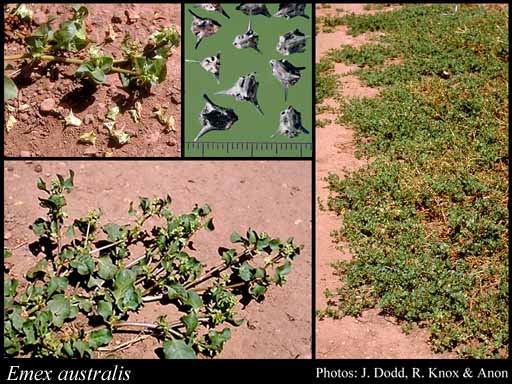This name is not current. Find out more information on related names.
- Reference
- Ann.Sci.Nat., Bot. Ser. 2, 9:195-196, Tab. 7, Fig. 16 (1838)
- Conservation Code
- Not threatened
- Naturalised Status
- Alien to Western Australia
- Name Status
- Not Current
Prostrate annual, herb. Fl. green, Jan to Dec. Sand, loam or clay. Disturbed areas, weed of cereals, road verges.

Management Notes (for the Swan NRM Region)
Alternative Names. Three-cornered Jack, Spiny Emex.
General Biology. Growth form. Herb. Life form. Annual. Reproduction. Seed. Dispersal. Tyres, water, machinery, soil movement. Toxicity. Contains oxalates suspected of poisoning stock. Seedbank persistence. 4+ years.
Notes. Can set seed and produce fruit within 1 month of germination. Germination generally follows seasonal rainfall patterns. Seed buried down to 1cm will germinate; deeper burial inhibits germination. Has a thick tap root. Sharp spines of fruit can injure animals, damage tyres and restrict the use of recreation areas. Is a relatively weak competitior whose impact can be reduced by maintaining vegetation cover. A biological control program in Australia led to reductions in seed produced.
Additional information. Origin. Southern Africa. History of use/introduction. Originally imported as a vegetable. Similar exotic species. Emex spinosa.
Suggested method of management and control. Any control program must aim at killing all plants shortly after emergence and should continue for a number of years. Herbicides will give poor results applied to plants with more than 12 leaves at the time of spraying. Spot spray plants with 1% Grazon® or glyphosate at 0.5-0.7% to kill existing plants. Alternatively wipe actively growing plants with 50% glyphosate. Bare soil can quickly become reinvaded. Read the manufacturers' labels and material safety data sheets before using herbicides. For further information consult the Australian Pesticides and Veterinary Medicines Authority to determine the status of permits for your situation or state.
Management Calendar
| Calendar Type | Jan | Feb | Mar | Apr | May | Jun | Jul | Aug | Sep | Oct | Nov | Dec | Comments |
|---|---|---|---|---|---|---|---|---|---|---|---|---|---|
| Germination | O | O | O | O | Y | Y | Y | Y | O | O | O | O | |
| Active Growth | Y | Y | Y | Y | Y | Y | Y | ||||||
| Flowering | O | O | O | Y | Y | Y | Y | O | O | ||||
| Fruiting | O | Y | Y | Y | O | ||||||||
| Manual Removal | Y | Y | Y | Y | Y | ||||||||
| Herbicide Treatment | Y | Y | Y | Y |
Legend: Y = Yes, regularly, O = Occasionally, U = Uncertain, referred by others but not confirmed.
References
- Brown, K. & Brooks, K. (2002) Bushland Weeds: A Practical Guide to their Management. Environmental Weeds Action Network, Greenwood.
- Cheam, A.H. (1987) Emergence and survival of buried doublegee (Emex australis Steinh.) seeds. Australian Journal of Experimental Agriculture, 27 (1): 101 - 106.
- CSIRO (2006) Biological control of Emex: the weed and potential agents. CSIRO Australia URL: http://www.csiro.au/resources/ps2hf.html - Accessed April 2010.
- Department of Primary Industries Queensland (2007) Spiny Emex. State of Queensland URL: http://www.dpi.qld.gov.au/documents/Biosecurity_EnvironmentalPests/IPA-Spiny-Emex-PP39.pdf.
- Gilbey, D.J. (1977) Selective chemical control of doublegee (Emex australis) in legume pasture. Australian Journal of Experimental Agriculture and Animal Husbandry, 17 (84): 80-85.
- Gilbey, D.J., Weiss, P.W. & Shepherd, R.C.H. (1998) Emex australis Steinh. In The Biology of Australian Weeds Vol. 2. (eds. F.D. Panetta, R.H. Groves, and R.C.H. Shepherd). R.G. & F.J. Richardson, Melbourne.
- Hussey, B.M.J., Keighery, G.J., Dodd, J., Lloyd, S.G. & Cousens, R.D. (2007) Western Weeds. A guide to the weeds of Western Australia. 2nd Edition. The Plant Protection Society of Western Australia, Victoria Park.
- Moore, C.B. & Moore, J.H. (2002) Herbiguide, the pesticide expert on a disk. Herbiguide, PO Box 44 Albany, Western Australia, 6330.
- Panetta, F.D. & Randall, R.P. (1994) An assessment of the colonising ability of Emex australis. Australian Journal of Ecology, 19: 76-82.
- Pannetta, F.D. & Randall, R.P. (1993) Emex australis and the competitive heirachy of a grazed annual pasture. Journal of Applied Ecology, 30: 373-379.
- Parsons, W.T. & Cuthbertson, E.G. (2001) Noxious weeds of Australia. 2nd Edition. CSIRO Publishing, Collingwood.
- Scott, J.K., Bowran, D.G. & Corey, S.A.( eds) (1996) Emex australis: Biology, management and research. Proceedings of a workshop held CSIRO, Floreat, WA on 11 December 1995. Plant Protection Quarterly, 11 (4) URL: http://www.weeds.crc.org.au/documents/emex_australis.pdf - Accessed December 2007.
- Weiss, P.W. (1981) Spatial distribution and dynamics of populations of the introduced annual Emex australis in south-eastern Australia. Journal of Applied Ecology, 18 (3): 849-864.
- Weiss, P.W. (2006) Some effects of competition between Emex australis and E. spinosa. Weed Research, 17 (5): 321 - 324.